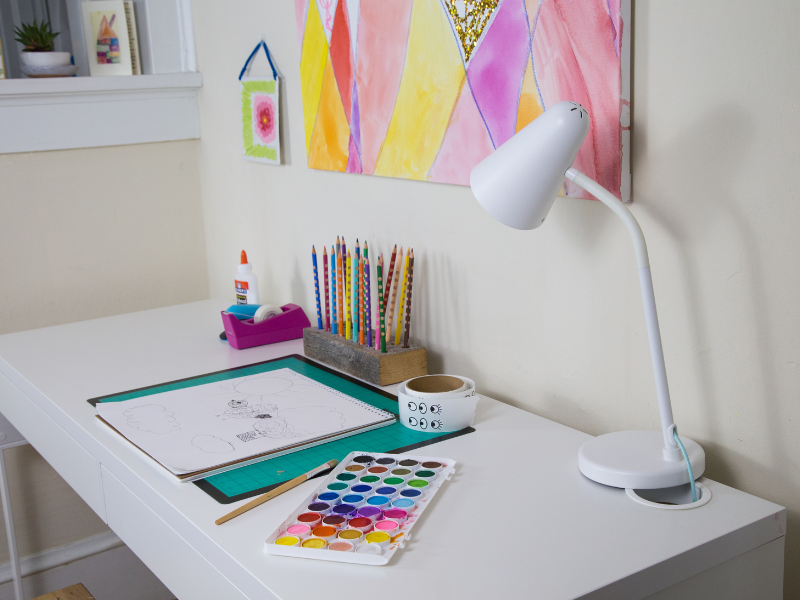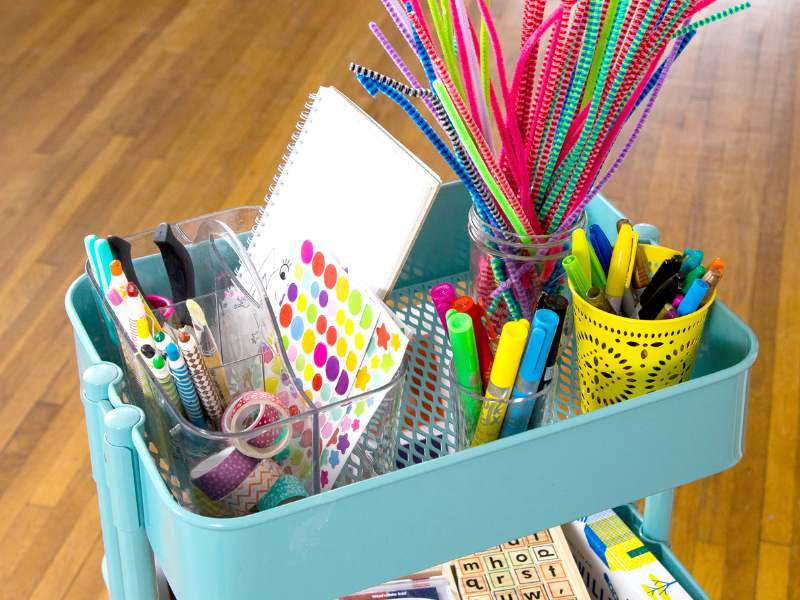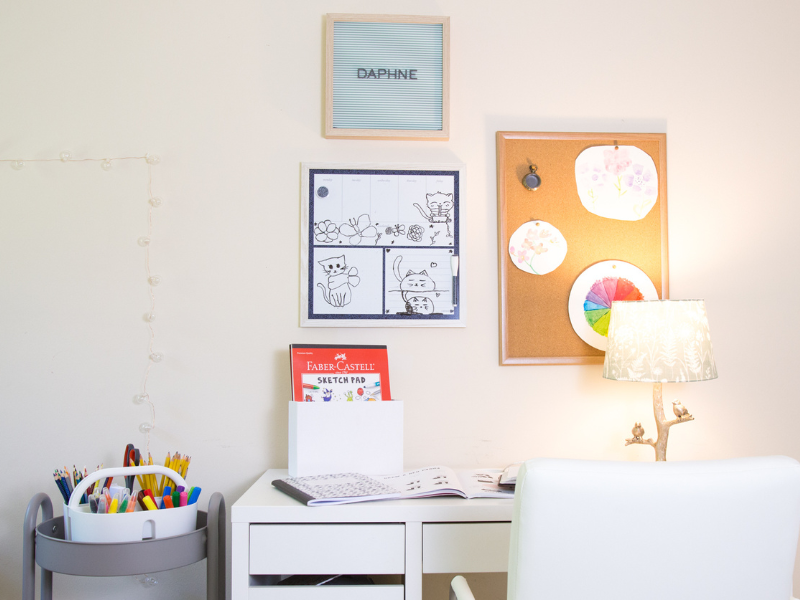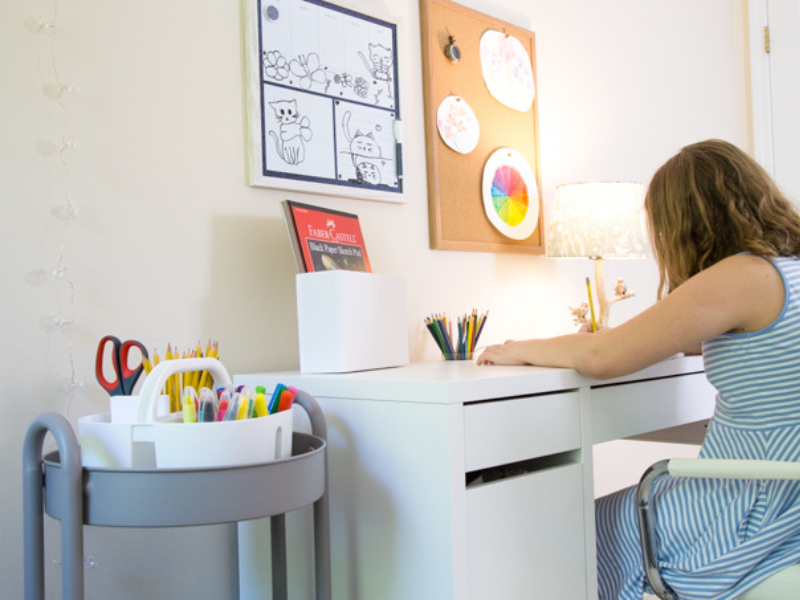How to set up a kids’ homework station at home. Plus download the free printable guide with ideas and checklists!
Updated March 2025
Setting up a dedicated homework station can make a big difference in helping kids stay focused and organized.
It doesn’t need to be elaborate—just a simple, well-equipped space with minimal distractions can create a productive learning environment.
Whether it’s a small desk or a quiet corner of the kitchen table, having a designated spot helps establish a routine. Here are some practical tips to create a homework station that supports concentration and makes study time more effective!
How to Set up a Homework Station at Home
This might look like one main learning station, or it might look like multiple learning stations in the different locations depending on your family situation, the size and layout of your home, and your children’s ages and needs.

1. Set up a desk or work surface. If you already have a desk or a work space for your child, great. If not, here are some ideas.
- You can pick one up at a big box store or furniture store.
- Or, perhaps there’s a table in your home that you can use as a desk, whether it’s a table you can dedicate to a learning station or the kitchen table that gets to serve multiple purposes throughout the day.
- You can search local secondhand sites like Craigslist or Facebook Marketplace, many of whom have safety policies in place.
Okay, now that you have a desk or other work surface, you also need a chair.
2. Add a comfortable chair. Your child’s probably going to be sitting in this chair a lot, so have your child help find a set up that’s comfortable for them. If you’re looking for a good value comfortable swivel chair, here’s one. We’ve had success with fidget or wobble cushions and balance ball chairs in the past, when kids needed extra help focusing and didn’t like to sit down or sit still.
Anything they can sit on that’s comfortable to work from is fine, though!
3. Ensure good lighting. You’ll need good task lighting. If your work area isn’t well lit, try a lamp like any of these.

4. Stock up on supplies. You’ll need all the normal school and art supplies such as paper, pencils, markers, scissors, and paints. You can find handy printable versions of these checklists (with even more ideas!) in the PDF guide at the bottom of this post. You can also check out our list of the best art supplies for kids.
Now that you’ve stocked up on school and art supplies, you might want a way to organize them.
5. Get organized! To help your kids learn without being stressed by clutter or by spending a bunch of time trying to find what they need each day, you’ll want to do your best to maintain a clear and organized desk and space. We love a rolling cart or art caddy for organizing supplies and keeping them off the desk/table as much as possible.
And don’t forget to help your child organize their time with a calendar and/or clock.
Now that you’re organized, you may want to consider some additional educational tools or supplies for your child’s at-home learning station or desk.

6. Educational extensions for learning at home. These are additional educational tools and supplies, such as globes, maps, educational posters, and science kits. These are completely optional, of course, but if you have the budget, it could be worth incorporating one or more of the following:
- People who don’t feel lonely in their later years often adopt these 9 habits that most people ignore until they’re struggling - Global English Editing
- The art of appearing effortlessly classy: 9 habits wealthy people practice without thinking - Global English Editing
- 10 things people over 65 stop caring about that younger people are still obsessing over - Global English Editing
Now that your child’s learning station is tricked out with educational tools and supplies, you may want to personalize it to make it extra special and comfortable.
7. Personalize your child’s homework station. Help kids feel excited about their learning area by personalizing it with their name, artworks, photos of friends and family, and more.
That’s a lot of ideas that we’ve just shared! Use them as a starting point as you create learning stations that work for your kids, your family, and your budget.
Want a printable guide with ideas and checklists to help you assess and adjust your current virtual learning desk area or to set up a learning station from scratch? You can download this printable guide for FREE! Just click the link or refresh the cookies on this page if you missed the email opt-in.
More Tips on Setting Up Kids’ Art Spaces
- 6 Tips and Ideas for a Kids’ Art Room
- Create a Kids’ Craft Room that Gets Used!
- How to Organize Art Supplies for Kids
- 21 Kids’ Artwork Display Ideas for Your Home
- 6 Kids’ Artwork Storage Ideas
- 6 Craft Room Ideas for Kids
Pin It For Later

This post is sponsored by Faber-Castell USA and some of the Faber-Castell supplies pictured were sent to us for free for the post. I only promote products I love and believe will be of value to you as well. All opinions expressed are my own.


